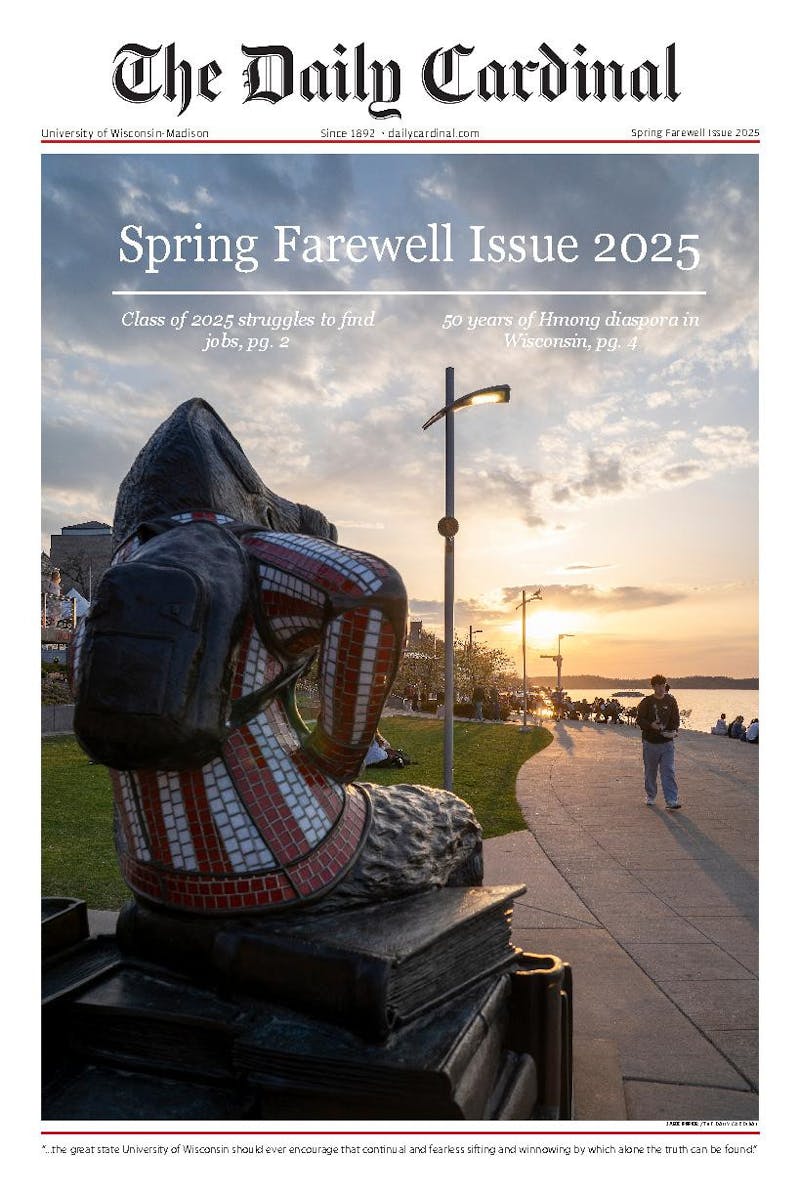Wine is thought to evoke great conversation, but rarely is conversation made of wine. In one glass, all spectrums of academia can be tasted, from botany to religion. Unofficially, Wine 101 can be studied across campus, by throwing wine parties to taste test its endless varieties.
Take a journey through the grape vines and learn the history, process and opportunities in wine tasting that Madison has to offer.
Wine is incorporated into the makings of every great civilization. Each one claims to have invented wine, attributing its discovery to a great hero or major agrarian deity. Perhaps the most noted connosieus are the Greeks, who not only invented wine, but immortalized it. Dionysus, the legendary god of wine, fertility and vegetation, is said to have worn a wreath of vines upon his head at festivities, perhaps the trendsetter for modern day toga parties. Dionysus festivities were known to be drunken parties, or Komos, a term which is also the origin of our word for comedy. Dionysus' once said giving wine to the world and making people happy is the cause of humanity. Perhaps it's time to party like Greek gods and follow Dionysus wisdom.
Greeks also introduced health implications of wine. Ancient Greek Hippocratic doctors adviced wine for digestion, circulation, fevers, nervous disorders and melancholy. Today, its antioxidants are said to decrease the risk of heart disease and doctors recomend drinking one to two glasses of red wine each day.
Like the Greek's withstanding wisdom, the components of wine haven't changed.
There are five essential steps to making wine: harvesting, pressing, fermenting, clarifying and aging/bottling. Harvesting has traditionally followed the moon for appropriate timing with natural cycles of life. Timing is crucial. When the grapes are perfectly ready, they are traditionally hand-picked. Mechanical picking is used today, but not preferred because it is hard on the grapes.
After being harvested, the grapes are pressed. Imagine stomping grapes, or close your eyes and flash back to the \I Love Lucy"" episode...it isn't easy! Stomping, or pressing, squeezes out the concentrated sunlight and water from the juice that is known as one of the most healthful beverages of all time. Now, mechanical techniques have taken the ritual and human touch out; however, grape stomping remains a tradition at local vineyards each fall.
Although grapes ferment naturally inside and burst open, most vineyards today kill the wild, unpredictable strain of natural yeast and add, heir own for reliable results.
""Each time we refine the fermentation process, we get greater control [of the product],"" said Jim Steele, UW-Madison professor of food science and researcher in food fermentation.
After six to twelve hours, fermentation begins. It continues until all sugar has been converted into alcohol, which can last ten days to one month.
""Most microorganisms can't survive in ethanol,"" said Steele. ""With fermentation, wine is less susceptable to spoilage.""
As shorter fermenting time results in sweeter wine. Red grapes produce many shades of red wines due to the amount of time the grape skin sits in the alcohol. White grapes make white wines which can range in color from yellow to green.
Next, wine is siphoned from one barrel to the next to leave precipitates and solids in the fermenting tanks. Wine is clarified by adding egg whites or clays, which precipitate dead yeasts and solids out. Wine can be bottled right away or aged in stainless steel, ceramic tanks, large wooden ovals or small barrels called barriques (proudly invented by the French who are traditionally renowned for the best wines). There are endless techniques to this final stage, which creates a great variance in wines. Cooler climates produce about 10 percent alcohol, whereas warmer climates make 15 percent.
After learning the composition of wine, it's time to show off your skills! Madison offers numerous venues for wine tasting, from the Union's Mini Courses, to wine boutiques and vineyards.
The Wisconsin Union offers three classes that relate to wine tasting: Wine Journey Workshop- California, Wine Journey Workshop- Australia/New Zealand and Wine Appreciation. Wine Journey Workshop-California costs $29.50 for one workshop on Tuesday, April 19th. Wine Journey Workshop-Australia/New Zealand also costs $29.50 and meets Wednesday, April 6th. Prices cover tasting fees and remember, you'll have to prove you're 21 before the session starts. During these two workshops, attendees learn how to compare prices, read reviews and most importantly, improve their tasting palates.
The Union offers one other class in wine tasting: Wine Appreciation. Though the $79.50 price tag is steep, attendees learn all about wine over four meetings opposed to only one. Unlike other wine workshops, there are already three people on this class's online waiting list. The number of sessions offered for each class ""depends on how many people are on the waiting list,"" said Arezou Daneshi, program planner and one of three supervisors for the Wisconsin Union's Mini Courses.
""We try to keep the quality of the classes really high,"" said Daneshi.
Vineyards are the perfect place to see, learn and taste about wine, and surprisingly, California isn't the only place with vineyards.
Botham Vineyards, 8180 Langberry Rd., near Mt. Horeb, was named one of the top U.S. wineries in 2000. Weekend tours begin March 1st and guided tours can be made by appointment by calling 1-800-GR8-WINE.
Wollersheim Winery, 7876 State Rd., Prarie du Sac, offers guided tours daily with tasting at the end. Reservations for tours can be made by calling 1-800-VIP-WINE.
Guided tours for each winery cost $3.00 and are for fifteen or more.
The Wine Boutique, 6220 University Ave., offers wine tasting sessions each Tuesday and Thursday from 5 - 7 p.m. Tastings draw a knowledgeable crowd of many regulars who grow a little flushed and chatty after tasting champagne-both red and white from featured regions. Before stepping foot into one of Madison's many wine tasting venues, it helps to know how to speak their language.
It is easy to be intimidated by all the swirling, sniffing and swishing, especially when asked what you taste. How does one describe wine?
Descriptions are rich and thorough using names of all fruits except the grape to describe the spectrum of tastes. First look at the clarity of the wine while swirling. Then bring your nose into the glass to fully smell the taste. Stop and think about how it impacts your senses and then how it feels on your tongue. How long the taste lingers determines the length of the finish.
Use the following example as a guide to charming fellow wine enthusiasts: While a Sauvingon Blanc may have intense aromas of passion fruit, hints of spicy oak are defined by clean refreshing flavors with a lengthy finish.
Here are some classic wine terms offered by www.tasting-wine.com that can help make the idea of wine tasting a little less intimidating. Wines can be expressed as full-bodied, medium-bodied or light-bodied depending on their weight in the mouth. The wine that forms on the side of the glass after being swirled is referred to as its legs. Length is the time aroma and taste linger after swallowing the wine.
The fine art of wine tasting is a process that is only perfected over time. Enroll in Wine 101 today and you'll be on your way to becoming a Greek god of wine.





